The people’s art
February 27, 2014
From a rammed earth sculpture in the high desert to glimmering bronze leaves channeling the olive groves of yesteryear, the county’s civic art collection is as diverse as Los Angeles County itself.
And it’s growing fast.
In just the past four years, the program has added 58 new artworks and restorations to its collection. The new works join a vibrant array of earlier projects commissioned and managed by the Los Angeles County Arts Commission as part of the Civic Art Program, which requires that 1% of the design and construction costs on new county capital projects be set aside for art.
Since the Board of Supervisors approved the program in December, 2004, a total of 80 projects have been completed at L.A. County facilities. And more are on the way, including the first $1 million civic art endeavor, at the Martin Luther King, Jr. Medical Campus, as well as projects at the renovated Hall of Justice and the new San Fernando Valley Family Support Center.
Margaret Bruning, who directs the program, said the aim is to “create artworks and facilities that reflect who we are as a community and a culture, where we are now—and where we think we’re going.”
“We often say that civic art is about the art of the place…But it’s more than just art in the pure sense,” she said. “It’s about people and their experience of this place and of each other. And I think that’s the civic-mindedness that comes through in civic art.”
As the program’s 10th anniversary approaches, take a spin through the photo gallery below to appreciate some of the compelling, beautiful or just plain fun artwork that has been integrated into county facilities—from swimming pools and skate parks to libraries and fire stations—over the past decade.
Posted 2/26/14
Here comes the rain
February 26, 2014
The good news is that the rain has finally arrived.
Unfortunately, in some parts of Southern California, that threatens to be the bad news too.
Parched by drought and charred by wildfires, Los Angeles County has spent the week both cheering and dreading the Pacific storm systems that are predicted to soak California—and perhaps Sunday’s Academy Awards—with the wettest weather L.A. has seen since 2012.
“On one hand, the region is in sore need of drought relief, so we’re happy to have it,” says Kerjon Lee, county Department of Public Works spokesman. “But the hillsides around the Colby Fire, the Madison Fire, the Powerhouse Fire, even the Station Fire—those areas haven’t recovered.
“The hills no longer have vegetation or trees or shrubs to prevent erosion. And the upper crust of the soil has been scorched, so it’s less absorbent. Water runs across it as if it had a wax surface.”
In other words, don’t just grab an umbrella, L.A. County. Get ready for mudslides, too.
At the Department of Public Works, the situation is all-hands and the mission is twofold—first, to make sure in this drought that every possible drop of rainfall is captured, and, second, to protect local homeowners and businesses from a potential onslaught of coursing storm water and debris.
“We try not to be alarmist, but the threat right below the burn area of the Colby Fire in the foothills above Glendora is pretty serious,” Lee says.
To that end, he says, the department has been partnering not just with Glendora but with cities throughout the foothill burn areas of the San Gabriel Valley. So far, DPW engineers have advised some 700 county homeowners and businesses on ways to protect their property in the event of rain.
Public Works crews also have been working since last year with state and local agencies, the U.S. Geological Survey and others to assess risk, clean out debris basins and install crib dam structures at strategic locations in burn sites.
Drought notwithstanding, the storm preparations have been intensive. In the area of last May’s Powerhouse Fire alone, for instance, the county has installed nearly a mile’s worth of concrete barricades, or k-rail, along Walkatop, Munz Ranch, San Francisquito Canyon and Elizabeth Lake roads, plus metal standpipes at more than a dozen locations and more than 2,100 feet of embankment protection, all during the last eight months.
That’s not counting the routine storm preparations the department does every year in the county’s massive flood control system, which includes 14 major dams, 487 miles of open channels and 2,919 miles of storm drains. Or the prep work done by Los Angeles city sanitation crews, whose jobs have included clearing the catch basins near Hollywood’s Dolby Theatre, where the red carpet for Sunday’s Oscars is already out (and covered in rainproof plastic).
Nor does it include longer-term projects like La Canada’s Mullally debris basin, which was expanded in late 2010 after winter storms the prior year clogged its drainage system. (Debris from the 2009 Station Fire had been brought down by the rainstorms, and the backup had inundated nearby homeowners with a wall of mud.)
While DPW crews try to prevent storm water from inundating local roadways, county “storm boss” Michele Chimienti , who heads dam operations for the department’s water resources branch, will be trying to save as much of it as possible.
This week’s storms, heavy as they may end up being, won’t reverse the drought that has dogged California for the past three years; in fact, the overall lack of precipitation has been such a concern that this week, the Board of Supervisors extended the county’s lease on its two Super Scooper fire-fighting aircraft.
But one function of the county dams is to gather water that can be released periodically to replenish the underground aquifers that, in turn, generate about a third of the region’s drinking water.
Right now, Lee says, most of those dams are at less than 5% capacity, so there’s plenty of room for more.
While the county battens down the hatches of its infrastructure, homeowners can make their own storm preparations.
Appearing before the Board of Supervisors this week, Public Works Director Gail Farber reminded the public that the county’s Coordinated Agency Recovery Effort web site will be updated as the storm progresses with information on road conditions, flooding, forecasts, emergency contacts, disaster preparedness and assistance programs. (For details, click here.)
The Los Angeles County Sheriff’s Department suggests that, if you haven’t already, you should sign up for free public safety alerts from the department via Nixle. They also are offering tips on storm-proofing your vehicle—and your driving habits.
DPW also has this handy list of places to obtain free sandbags and this free guide to flash flood preparedness. For homeowners interested in rain barrels, the City of Los Angeles offers this guide to rainwater harvesting.
And one more bit of advice from the experts: Don’t forget to turn off your sprinklers. With any luck, the upside of this storm will carry over onto your water bill.
Posted 2/26/14
Dial M for Metro WiFi
February 25, 2014
Hold the phone: after years of study, a project to bring WiFi and cellular service to L.A.’s subway system is now underway.
The project is on track for completion by January, 2016. But Daniel Lindstrom, Metro’s manager of wayside communications, said that work will likely take place in stages, with segments of the system—such as stations in the downtown L.A. business district—potentially coming on line earlier.
Work began in January. For now, they’re dealing with what Lindstrom calls the “techie stuff,” like where to locate a 2,000-square-foot “base station hotel” that will house equipment for cell phone providers that join the Metro network.
The company chosen to develop and operate Metro’s system, InSite Wireless, has already brought WiFi and cell service to Boston’s decades-old subway system, known as “The T.”
“If you can implement it in a 100-year-old subway, you can definitely implement it on a modern system like ours,” Lindstrom said.
Lindstrom said he could not estimate how many people will use the service when it is up and running in Los Angeles, but noted that there is particularly strong demand among younger passengers, whereas older riders tend to have more of a take-it-or-leave-it attitude.
“If you’re in your 20s, like my kids, they say, ‘Why don’t you have cell phone coverage in the subway? What’s wrong with you?’ ” Lindstrom said. “I’m just about to hit 50, and I think it’s nice to have but I don’t necessarily expect it. And if you’re in your 80s, you say, ‘Just forget about it.’ ”
Riders of the Red and Purple subway lines won’t be the only beneficiaries of the new service; it will also cover below-grade portions of the Blue, Gold and Expo lines, along with the future Crenshaw Line.
Lindstrom said that people with data plans through their individual cell phone service will be able to use their devices on Metro free of charge. Those who don’t have such plans will pay as they go when they sign into the network on a platform or in a subway car, much as they currently do on airplanes—or in other underground systems around the world.
“London makes you pay $3 a day,” Lindstrom said.
Lindstrom said Metro is hoping to offer an early taste of what the system will offer by having Union Station’s WiFi up and running by its 75th anniversary later this year.
When the whole system is online, Metro will receive at least $360,000 a year from the program, and its share of revenue from InSite could potentially be far greater. A report last year to the agency’s Executive Management Committee said that Bay Area Rapid Transit in northern California reported $2 million a year in new revenue after it installed cell and data service.
The service also will enhance security by enabling passengers to call for help if needed. And, Lindstrom said, it will allow sheriff’s deputies and security officers to view and respond to real-time video feeds.
“It’s a force multiplier,” Lindstrom said. “It will allow deputies to see things as they are going on.”
Posted 2/21/14
Metro’s bicycle brain trust
February 25, 2014
There was once a time, not long ago, when bicyclists weren’t much more than a squeaky wheel to Metro—and not in a good way.
What a difference four years makes.
On February 19, 2010, the cycling community got a seat at the transit table when Metro hosted its first Bicycle Roundtable meeting.
It was the beginning of an important collaboration—one that would lead to some major improvements for cyclists within the Metro system. But you wouldn’t have known it from the rocky start of the process, as cyclists started engaging warily with a government agency that hadn’t always been so welcoming.
“They distrusted us and were very assertive about issues we needed to address and policies we needed to embrace,” said Diego Cardoso, Metro’s executive officer in charge of the bicycle and pedestrian program. “Those were the days when Metro was transitioning as an agency in terms of mobility and bicycling in L.A. County.”
Intended as a forum for bike advocates to exchange ideas with the transit agency, the meetings grew out of a rising tide of vocal cycling activism. “The bicycle community was demanding in terms of getting Metro, cities and the county to deal with issues of how to improve mobility for bicycles,” Cardoso said. “We said ‘Well, let’s bring them together.’ ”
Though contentious at first, the discussions soon evolved in ways that have helped shape the emergence of cycling as a major mode of transportation in the county.
One of the earliest results was the end of a ban that kept bikes off trains during peak periods of travel. What’s more, the agency has even removed seats from rail cars to clear more room for cyclists to bring their rides aboard. And Metro has more than doubled the share that bicycles get in its competitive Call for Projects program, which funds local initiatives with regional significance. (Cycling programs now get 15% of the pot, which in the last cycle totaled $199.4 million.)
The collaboration also has led to new public education programs promoting safety. The highly visible “Every Lane is a Bike Lane” campaign grew out of roundtable discussions, and last summer, Metro launched bicycle safety classes taught by advocacy groups that attend the meetings.
On the political side of things, Metro’s Board of Directors has provided support as well, officially recognizing bicycling as an official “mode of transportation,” putting it on equal footing with motorized travel.
Next up: bike-sharing.
“Bike share is a good example where they basically asked ‘What do you think?’” said Eric Bruins, director of policy and planning for the L.A. County Bicycle Coalition. “Feedback from the roundtable was very clear—there should be one regional vendor and we want to see a strong leadership role from Metro.”
The agency, spurred by a motion by Mayor Eric Garcetti, Supervisor Zev Yaroslavsky and others, stepped in after the city of L.A.’s bike share program foundered and took the lead in creating a county-wide bike sharing plan. In December, Metro’s board expanded the agency’s role, directing it to fund the plan by teaming up with local jurisdictions.
An update on the bike share project’s progress—including input from the roundtable group—is scheduled to come before Metro’s board in April. According to Cardoso, the agency is in the process of contracting with an outside company to help implement the program, with Los Angeles, Santa Monica and Pasadena serving as pilot cities.
Another upcoming project aims to build five new “bike hubs,” structures that will offer secure parking, repairs and other resources, at major public transportation hotspots. The first one, at El Monte Station, will open later this year. Other hubs are planned for Union Station, Culver City Expo Line Station and two Red Line stations—Hollywood/Vine and North Hollywood.
The roundtable’s most recent meeting earlier this month drew a mix of cycling aficionados, staff from government agencies and the offices of elected officials and even a couple of unaffiliated members of the public. Attendees came from all over: Santa Monica, Montebello, even Orange County.
One regular participant, Dennis Hindman, 61, of Toluca Lake, said he’d like to see more folks from the public take part in helping the agency get more of a grassroots perspective. “It gives you the insight of actual experience,” he said. “You may have missed something from a practical standpoint that just won’t work in real life.”
Miguel Ramos, a volunteer for Multicultural Communities for Mobility, was attending for the first time. Ramos’ mission is to promote inclusion of all of the region’s diverse communities in bicycle projects—something he said is simply “not happening in low income communities” nationwide.
“These communities already have a growing bicycle culture,” Ramos said. “It’s about recognizing that fact and allowing their voices to be heard.” To achieve that, he said, Metro must increase outreach in multiple languages.
For his part, Bruins of the Bicycle Coalition said he would like to see a higher level of participation by a broader range of Metro staffers.
“Metro has many departments,” Bruins said. “We’d like to see other departments come to the bike roundtable because it’s really that exchange of ideas that’s helpful. The folks that are designing the next set of light rail vehicles came and presented designs of how bikes can be stored on board. Those are great discussions because they allow departments that don’t usually deal with the bike community to interface with us.”
Even today, bicyclists and the agency don’t always see eye-to-eye. Many cyclists are pushing for the installation in rail stations of “bike channels”—deep grooves next to stairways to make it easier for bikes to get up and down. That, however, would be expensive, and retrofitting existing stations with the channels would be even costlier, said Laura Cornejo, who oversees Metro’s Active Transportation Program and has led the past two roundtable discussions.
“Advocates are pushing for Metro to do more and be a little more aggressive,” Cornejo said, “but we have to be strategic and take baby steps to get to the final destination.”
But, she added, the days of bicycles as an afterthought in L.A. are long gone.
“All the trends point to bicycling growing,” Cornejo said. “We’ve seen it on rail, where bicycle boarding has increased about 40% in just one year. I don’t see the trend reversing or slowing.”
Posted 2/25/14
The beauty is in the details
February 20, 2014
There are moments in my job—special moments—when I know I’m representing not only the interests of people today but also the needs of generations to come. One of those occasions, I’m delighted to say, came this week with a historic vote by the Board of Supervisors to protect one of our region’s most precious environmental and recreational treasures.
On Tuesday, the board approved a Local Coastal Program (LCP) for an 80-square-mile area of the Santa Monica Mountains. Years in the making, this far-reaching document—required by the state and endorsed by a broad coalition—establishes rigorous new restrictions for development in the mountains that rise along Los Angeles County’s northern edge.
Among other things, the LCP will ban construction in the most fragile habitat areas to help ensure the survival of animal and plant life, including our oak woodlands. Natural streams will be allowed to flow without alterations or barriers. Certain deadly rodent poisons will be outlawed to protect mountain lions and other vulnerable creatures. Stars in the night sky will remain visible thanks to tough rules on outdoor lighting.
What’s more, development will be prohibited on all significant ridgelines to prevent scars that would ruin this magnificent landscape and undermine the outdoor experience for hikers, equestrians and others who’ve found refuge just minutes away from our urban sprawl.
Where development is allowed, zoning will be dramatically reduced from an average of one house per acre to as low as one per 40 acres. For grading that exceeds 5,000 cubic yards, a discretionary permit will be necessary, as well as environmental and public hearings. The current threshold for such actions is 100,000 cubic yards.
The board’s passage of the Local Coastal Program, which now goes to the California Coastal Commission for certification, also represents a dramatic shift in the stewardship of the Santa Monica Mountains.
For years, in the absence of a detailed LCP, applicants for development permits have needed approval from both the county and the coastal commission. This has added needless uncertainty, delays and costs to the process. The coastal commission, for example, currently requires a full hearing for nearly every permit. Under the county’s LCP, however, an administrative permit would be issued to people who want to build such basic structures as single-family homes or room additions that comply with the plan’s development standards.
So now the rules will be clear to all, and the elected Board of Supervisors finally will have responsibility for managing a priceless resource that draws tens of thousands of visitors to its trails and vistas each year.
In fact, the LCP itself reflects the views and priorities of a wide collection of groups and individuals who have a stake in the mountains and a passion for their continuing preservation as a rural outpost for Los Angeles. Among them are the Sierra Club, Heal the Bay, the Las Virgenes Homeowners Federation and the majority of local equestrians, whose interests are specifically addressed in the LCP. I thank them all for their heartfelt participation.
I also want to thank the county’s Department of Regional Planning and my deputy Ben Saltsman. Together, they shepherded this monumental effort, demonstrating how government can, indeed, build consensus and serve the public’s lasting interests. This plan sends a very clear message: In the Santa Monica Mountains, concerns for the environment will dictate development, not the other way around.
For more on the Santa Monica Mountains and their place in L.A., check out our video below.

Posted 2/20/14
L.A. traffic’s teachable moments
February 20, 2014
If they gave college credit for navigating the massive construction project on the 405 Freeway, Los Angeles would be well into its post-graduate studies. And Mike Barbour would be our road-weary faculty advisor.
As for big tests, well, the latest one came last weekend in the form of the 80-hour potential tie-up known as Jamzilla—and Barbour thinks we aced it.
“The public listens, I think that’s obvious,” said Barbour, whose actual job is managing the freeway improvements project for Metro. “If it would have been less than 60% traffic diversion, we would have had problems probably for the entire weekend.”
In other words, we stayed away from the construction zone in droves over the long President’s Day weekend—an outcome that wasn’t at all certain going in.
Dozens of work crews working on the northbound 405 put down thousands of tons of paving material—enough to pave a 9-mile sidewalk from Santa Monica to LAX. But only on the holiday Monday did traffic shows any signs of significant back-ups, and those were relatively short-lived and topped off at delays of about 45 minutes, Barbour estimated.
Shortly after Jamzilla was announced, Barbour acknowledged that he had his doubts about whether the driving public had become too jaded to heed the stay-away messages this time, given how smoothly everything had gone during two previous epic closures, Carmageddon and Carmageddon II.
Now, as he reflects on all three highly-publicized closures, he believes that the earlier experiences actually helped individual motorists realize how much their behavior could affect the outcome overall.
“I think they got it. They saw the benefit in the past of staying away, and this kind of carried through to this one. I don’t think we were crying wolf,” Barbour said. “People are not going, ‘Aw crap, they’re just making this stuff up.’ They’re thinking, ‘Yeah, it’s real. We’ll respond appropriately.’ ”
In fact, he believes there could be long-lasting lessons in traffic management and mass communication to grow out of the 405 Project experiences.
“This is actually kind of an amazing thing as far as dealing with traffic in L.A. Can we interact with the public on a regular basis to address these closures or impacts? Can we get them to start adjusting their habits and patterns? As things develop, can we get them to be responsive? Carmageddon and Jamzilla showed we can,” Barbour said. “And I think that’s a great thing. You could imagine what you could do with that if you could be more interactive on a regular basis with the public. Getting them to change their driving patterns and habits, that would be awesome.”
Now, with the “big milestone” of Jamzilla past and just one more potential 55-hour closure of the southbound 405 still in the works, Barbour is seeing the light at the end of the mega-project.
“Substantial completion,” meaning that people can drive the freeway and all of its improvements, including a new 10-mile northbound carpool lane, is set for this summer.
“Hopefully we’ll get it done the early part of the summer. All I can tell you is that there’s a real push. We are all just focused. Everybody’s pulling in the right direction,” Barbour said. “The sooner we get done, our lives get so much easier, and I think more importantly, the community is sick of this job. They’re sick of the impacts. That’s why we’re trying to do everything we can to minimize those right now.
“It’s been 5 years for me,” he added. “I’ve lived through thick and thin on this one.”
Posted 2/20/14
Metro’s hardest seat to get
February 13, 2014
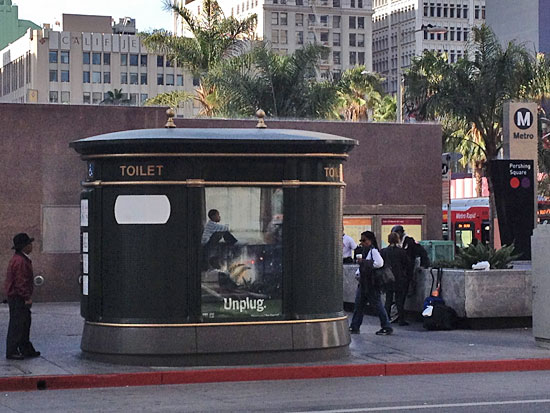
Despite a city-owned public toilet, Metro gets complaints of public urination at Pershing Square station.
As the saying goes, “When you gotta go, you gotta go.” That’s true whether you’re in a restaurant, a concert hall or riding a subway. But, despite public demand, installing restrooms at Metro stations is no easy business, according to the transportation agency, which recently undertook a study of the issue.
“We want to ensure that our customers have a great riding experience and have resources when a need arises, but there are a lot of elements that have to be factored in,” says Debra Johnson, Metro’s interim chief operating officer.
Although the agency has been grappling with the issue of public restrooms for years, Metro’s Board of Directors ordered a new look in November after residents near the Pierce College Station of the Orange Line busway in the San Fernando Valley complained that some riders were urinating in public. Among other things, Metro installed a video camera and monitored the area for 30 days, but couldn’t corroborate those complaints.
At the same time, the agency also was asked to take a look at the potential need for publicly-accessible restrooms at subway, light rail and bus rapid transit line stations throughout the system. The bottom line, according to a report that will be presented to the board later this month: Increasing the number of restrooms would not only be costly but could create crime problems unless security is enhanced at each location.
Currently, Metro maintains public toilet facilities at Union Station, the El Monte Bus Terminal and the Harbor/Gateway Transit Center—transportation “hubs” where staffers are present at all times. According to employee observations, restrooms in the busy Union Station were used consistently throughout the day. At the El Monte facility, five or fewer customers lined up during peak hours to use the free-standing automated public toilet, with less use at the Harbor/Gateway center.
The report notes that Metro employee restrooms are in place at Red Line subway stations but are opened to the public only in emergencies, as determined by Metro personnel. Generally, the report said, “customers are informed no public toilets are available,” even though it’s not uncommon for Red Line riders at the large 7th Street station to ask about the availability of public restrooms.
The agency, in its report, acknowledged the unpleasant realities that confront customers at some stations.
“Metro’s custodial staff report on-going issues with public urination and defecation at several of the rail stations as well as inside many of the station elevators,” the report said, adding that “other areas of public urination include the top side of subway station entrances such as Pershing Square, where loitering is common.”
But the agency pointed to the complexities of opening new restrooms with a cautionary tale of what happened when The W Hotel, located above the Hollywood and Vine Red Line station, agreed to provide a street-level public toilet as part of their contract with Metro.
According to Metro, the facility “became a magnet for the area’s homeless population which impacted the use by Metro’s customers. While open, the hotel developer was expending an average of $250 per day on paper products and had to replace three sinks, three mirrors and five toilet seats due to damage.” The restroom was labeled a public nuisance and was shuttered less than 4 months after its opening.
Johnson, Metro’s interim operations chief, notes that these kinds of problems are not limited to Metro operations. “It’s something that plagues us in today’s society considering the amount of people who don’t have access to facilities,” she said. “You could be walking around a city street and step around a puddle of urine. Collectively, I think there is an issue that needs to be addressed holistically.”
There’s also the price to consider. According to her department’s report, individual hard-wall toilets cost up to $700,000 to install and require regular stocking, maintenance and cleaning. In December, Robin Blair, the agency’s planning director, estimated that it would cost $70 million annually to maintain restrooms at every station. The agency estimates that the free-standing automatic public toilets would cost about $600,000 for two units, plus considerable custodial costs.
Then there are the public safety issues that come with adding restrooms to the system, thus creating a venue for illegal activity. “If you go anywhere in the world where people have tried this,” Blair said, “all of your problems are in the restrooms—crime, muggings, shooting up—all sorts of human degradation.”
“It’s up to the Board [of Directors] to decide what direction to take,” Johnson said. “For staff, our first and foremost mission is to ensure a safe environment for the riding public.”
No rider, of course, would argue with that goal. But a good number of them, like Renee Briddle, 38, who commutes 2 hours from Long Beach through downtown Los Angeles on the Blue and Red lines, think the status quo stinks.
Briddle was standing next to a small pool of urine the other day in a Civic Center station elevator. “It smells like that all the time,” she said, adding that such conditions are not uncommon, as Metro itself admits. One time, Briddle confided, she herself had an accident during one of her long commutes. “We need bathrooms,” she said, before hurrying on her way.
Posted 2/13/14
Always a holiday for pet adoption
February 13, 2014
Some people just have a knack for matchmaking. Elaine Seamans, for instance, has arranged hundreds of long-term relationships.
Last Halloween, she helped kindle more than 80 love affairs in a day at the county’s Baldwin Park animal shelter. Dozens more found the mate of their dreams at her Fourth of July and St. Patrick’s Day pet-to-person meetups.
And this week, the county Department of Animal Care and Control will be expanding the shelter volunteer’s signature love fest—a hearts-and-flowers pet adoption extravaganza that has found homes for nearly 100 stray and abandoned animals during the last three years.
“The idea was just to use the holidays to celebrate adoptions,” says Seamans, a 58-year-old Valley Village designer who has been organizing “My Furry Valentine” at the Baldwin Park shelter since early 2011. “But this has just gotten bigger and bigger every year.”
Colorful and festive, the event turns the shelter into a giant Valentine for one day, welcoming prospective pet owners with chocolate, gift bags, music and doggie kisses. This year, each of the county’s six shelters will hold a more or less elaborate version of the Baldwin Park celebration through the Valentine weekend, with the usual $50 adoption fee discounted to a heartfelt $14.
Holiday-themed adoption events have been a growing trend for some time at rescue nonprofits—the Found Animals Foundation has long held an annual “Happy Pawlidays” campaign in December, for instance, and the Best Friends Animal Society holds an “aCATemy Awards” tied to Oscar season. But until recently, it was unusual for a county shelter to initiate this kind of promotion, according to animal control officials.
The reluctance stemmed partly from an ambivalence about holiday adoptions. People are tempted to give pets as gifts, “and having a pet isn’t like getting a sweater that you can return—it’s a lifetime commitment,” says county Animal Care and Control Director Marcia Mayeda.
But, she added, county shelters were also slow to get on the holiday bandwagon because the shelter staff is consumed with day-to-day animal care duties. Only in the past decade, she says, has the county shelter system developed a volunteer program with the base and coordination to do fundraising and event planning, and “a lot of this is dependent on volunteers.”
Seamans, who has been volunteering with Best Friends and other rescue nonprofits since the 1998 death of her dachshund Quackers, had been donating her time for about a year at the Baldwin Park shelter when she suggested to shelter manager Lance Hunter that more could be done to find homes for the bereft dogs and cats in the shelter kennels. That, she says, is when she pitched the Valentine idea.
“It started out as just this little grassroots thing with just a couple of volunteers and some decorations,” says Hunter. But when their usual rate of eight or ten adoptions per day nearly tripled, he says, he took Seamans up on her offer to do more holiday events.
Since then, he says, other county shelters have begun hosting their own festive campaigns, and no holiday has been left behind when it comes to rustling up homes for pets at the Baldwin Park shelter. Last year, Seamans and her fellow volunteers organized events at Christmas, Valentine’s Day, the Fourth of July and Halloween, which Hunter said “topped the charts” at the shelter for holidays.
Among the attractions at the Halloween event were a fog machine and buckets where humans could bob for apples and dogs could bob for cocktail wieners, says Seamans. But “My Furry Valentine” is still the most elaborate promotion.
“Last year Elaine put frames and flowers around the outside of the kennels, and hung signs all over that said things like, ‘Your Best Friend Awaits’ and ‘Your Heart Is Missing Something’,” laughs Hunter. “We even had face painting and a ‘kissing booth’ built with some of the donations. And she got a young actor she knew to dress up as Cupid.”
“This year we’re getting a harpist,” adds Seamans. “This woman is donating her time in honor of her retriever, who passed away in January. Can you imagine? A harp player in the kennel! I’m dying to see how the dogs react to that.”
Mayeda says holiday events not only save pets’ lives, but also generate donations to the county’s Animal Care Foundation and improve morale among the county’s now-thriving ranks of volunteers.
They also put a friendlier face on the county system, says Seamans.
“A lot of people think shelters are scary,” she says. “They think they’re death camps, or where the ‘problem dogs’ go.”
But when people actually meet the pets, she says, they’re less concerned about their surroundings. All three of the dachshunds she has now—Quizzie, Fred and Doodles—were strays or abandoned. And after the 2011 event at which her teenaged actor friend Lou Wegner played Cupid, he returned to shoot a music video at the Baldwin Park shelter to benefit pet rescues.
In any case, she says, few things are more heartwarming than matching the perfect pet with the perfect family. Take, for instance, the note she got from a young mother who adopted a little dog for her 6-year-old son on a therapist’s recommendation last Valentine’s Day.
“Ohhhh, she is soooo good. Her name is Sassy,” the mother emailed. “Since the day we brought her, she let us know when to take her outside . . . She does love the bed, so we suckered her into sleeping with us or the kids. She is perfect for us—thank you.”
And that, she says, is just the product of one love story among hundreds.
“I tell people that the shelter is where your best friend is waiting,” says Seamans. “These animals are out there just waiting to show you how great you are.”
For more on “My Furry Valentine”, click here. And for more on the county’s other pet adoption programs, click here.
Posted 2/13/14
Jamzilla could be a monster
February 13, 2014
With officials keeping a close eye on the weather report and a couple of major sporting events, the gargantuan road-paving and lane-painting operation known as Jamzilla roars into action on the 405 Freeway this weekend.
In the days leading up to the 80-hour construction marathon, which runs from February 14-18, the weather forecast has been of more than casual interest. That’s because a cornerstone of the planned work—a costly, fast-hardening polyester paving process that allows the contractor to move far more quickly than would be possible with conventional paving materials—requires temperatures above 50 degrees (and below 100 degrees) to work properly. With a warming trend pushing overnight lows into the 50s, officials held a “go/no-go” meeting on Wednesday and decided to proceed with the effort, which is a key milestone in the long-running project to bring a 10-mile northbound carpool lane and other improvements to the 405.
But the thermometer hasn’t been the only preoccupation as Jamzilla approaches.
Officials also are worried about the human factor.
While L.A. sailed through two previous weekend-long “Carmageddons” in which the entire 405 was shut down, this time around may be a different story—paradoxically, because the freeway will actually have a couple of northbound lanes open during the daytime all weekend long, as well as all of the southbound lanes.
“When the freeway is closed, it’s easy for someone to make the decision. But with lane reductions, it means there’s always a chance. There’ll be some people who’ll just go there and see what happens,” said Edward Yu, who directs the city of Los Angeles’ Automated Traffic Surveillance and Control Center (ATSAC), which will be closely monitoring the flow of traffic as Jamzilla unfolds.
Also, unlike during either of the previous Carmageddons, there are a couple of big sports events scheduled in the area and expected to draw thousands of spectators: the Northern Trust Open at the Riviera Country Club, starting Thursday and running through Sunday, February 16, and the UCLA-University of Utah basketball game at Pauley Pavilion on Saturday.
The Getty Center, meanwhile, is open for visitors and showcasing a Queen Victoria film series this weekend, along with ongoing exhibitions. Another Sepulveda Pass institution, the Skirball Cultural Center, is offering its regular weekend lineup of programs.
Metro, which is running the 405 Project in conjunction with Caltrans, estimates it will need to reduce the regular traffic volume on the 405 by two-thirds just to keep things moving normally.
Anything else, they warned this week, could produce an “80-hour-long Sigalert.”
“If we don’t have enough people staying off the freeway, we will have long congestion lines. That’s guaranteed,” said Metro spokesman Dave Sotero. “One-and-a-half or two hours stuck on the freeway is no fun for anybody—and it could be even worse.”
He’s not just blowing smoke. A shorter, but otherwise similar paving operation last March, billed as “Son of Carmageddon,” caused lengthy traffic jams on the 405, Sepulveda Boulevard and beyond.
“We had northbound traffic backed up to the 90. The 10 was gridlocked in both directions leading to the 405,” recalled Sotero, who memorialized the occasion with a frame grab of all the red lines depicting clogged roadways on that day’s Caltrans QuickMap.
It doesn’t have to be that way this weekend.
Anyone who doesn’t need to drive should make it a car-free weekend, Metro advises. Those who do need to travel should steer clear of the construction zone and choose other freeways to get around.
And everybody who plans to be in motion anywhere near the 405 this weekend, including on the Presidents’ Day holiday Monday, should make it a point to be up to date on exactly where and when Jamzilla is taking place.
Full details are here, but in a nutshell, this is what’s happening:
The affected area is a 5.6-mile stretch of the northbound 405 between Getty Center Drive and Ventura Boulevard.
During the daytime hours, three northbound lanes will be closed, with two left open.
At night, all five northbound lanes will be closed.
The entire operation should wrap up in time for back-to-work traffic at 6 a.m. on Tuesday, February 18.
Unfortunately, this is not the final extended closure planned for the project, which is expected to be “substantially completed” and open for driving by summer.
A 55-hour closure of the southbound freeway is now in the planning stages. A date has not yet been set, but K.N. Murthy, Metro’s executive director of transit project delivery, said the upcoming extended shutdown is needed to work on retaining walls, sound walls, shoulder paving and lane restriping.
When the $1 billion-plus project finally reaches the end of the road, it will leave behind the 10-mile-long carpool lane, three rebuilt bridges and some dramatically reconfigured Wilshire “flyover” ramps, along with other improvements.
Another benefit, for transit riders, may in the offing as well.
When the new carpool lane opens this summer, Metro is considering using it to introduce a new rapid bus line between the San Fernando Valley and the Westside. If approved and funded by Metro’s Board of Directors, the new line could offer service from the Valley to Westwood beginning this summer, and would extend further south to connect with the Expo Line when the second phase of the light rail opens to Santa Monica in 2015.
Posted 2/13/14




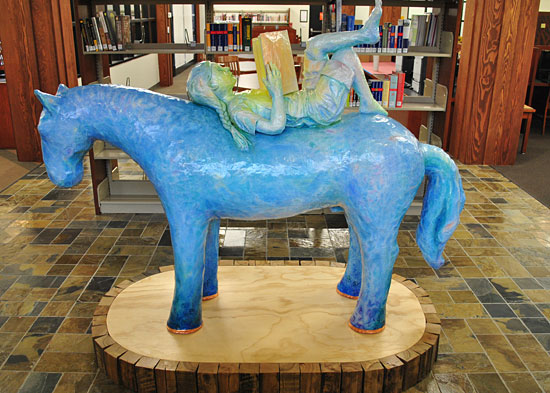






























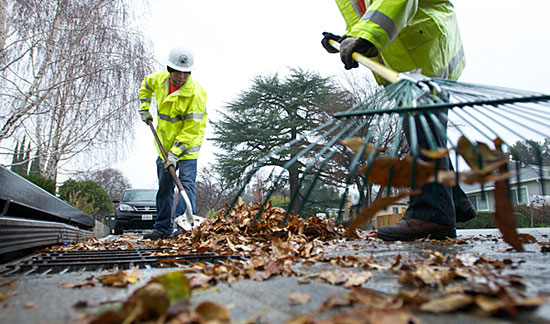
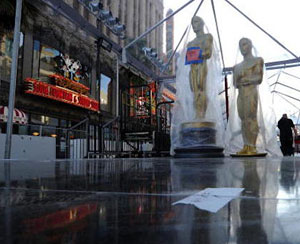
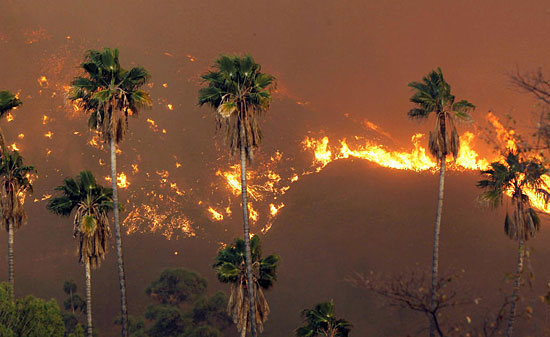
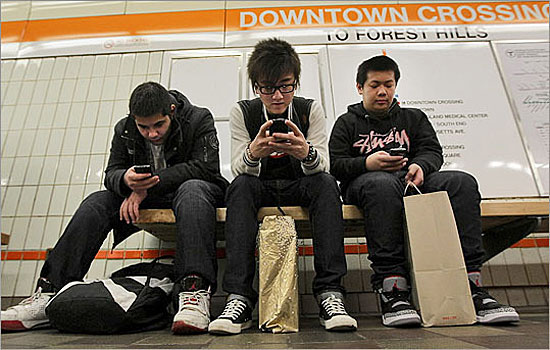



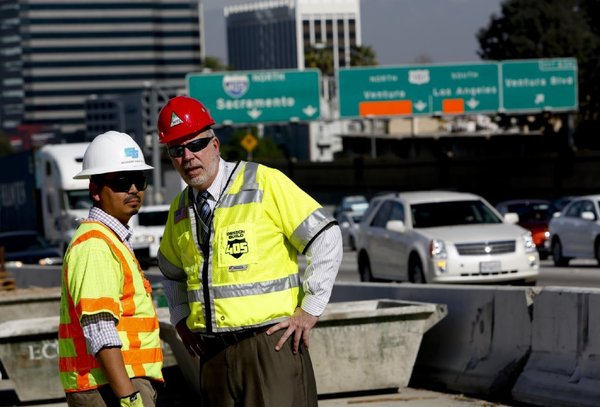
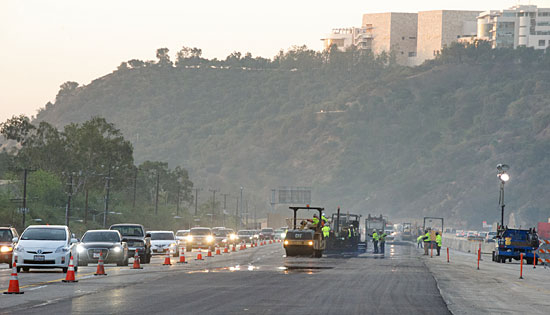

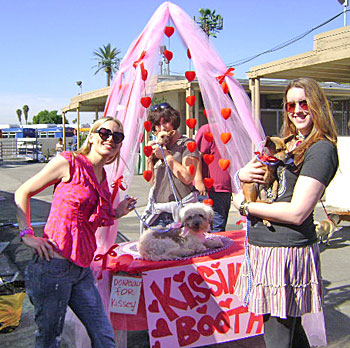
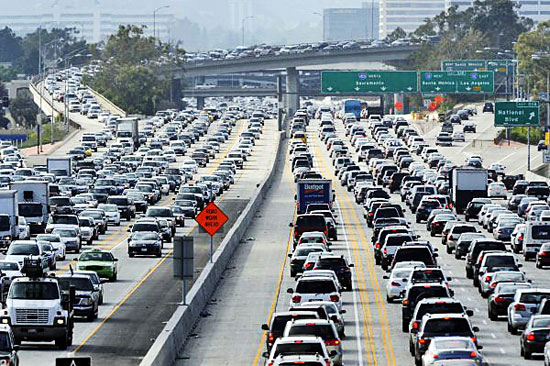





 Check for the latest closure information
Check for the latest closure information








